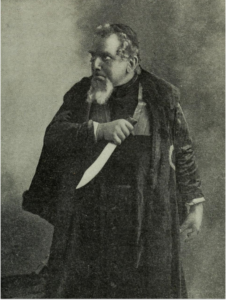16-year-old Noa Gomberg dives into the history of antisemitic tropes in culture and entertainment

Süsskind, the Jew of Trimberg, debating with a bishop and clergy. Codex Manesse, c. 1300–1440.
Picture by: Heidelberg University Library
Article link copied.
In my household, the 25th of December is dedicated to every holiday movie Netflix has to offer, especially the cheesy, guy-gets-the-girl romcoms. It’s our tradition and I’m a sucker for a running-through-the-airport scene. But there’s always something missing.
Jews.
All the festive movies are Christmas or Easter movies. In Netflix’s ‘holiday’ catalogue there are no Hanukkah movies or movies with Jewish protagonists. Sure, there’s the occasional Hanukkiah in the background, but rarely any substantial or particularly positive representation.
I wish this was a new issue or a victimless crime, but no such luck.
Harbingers’ Weekly Brief
The beginning of antisemitic tropes
To understand current antisemitic tropes in media, you need to understand antisemitism in the Middle Ages.
Judaism believes that the Messiah is someone who will return all Jews to our homeland of Israel and rebuild the temple in Jerusalem. Since Jesus did not address either of those requirements, Judaism does not regard him as the Messiah.
This threatened the Church because it delegitimised it. During the Middle Ages, the Church feared that if Christians saw Jewish people thriving, they would convert and there would be fewer donations to the Church.
The tropes that Jews are greedy, amoral, manipulative and predatory arise from the lies spread by the Church to maintain dominion over its subjects.
In 1144, a 12-year-old boy named William was found murdered in Norwich, England. A monk, Thomas of Monmouth, claimed local Jews had tortured and murdered him to use in their matzah dough. This was an entirely baseless accusation that established the idea that our religious practices were innately predatory.
This became known as the “blood libel” and led to pogroms – the violent, sometimes state-sponsored murder, rape and mutilation of Jews and destruction of Jewish property.
During the Middle Ages, the Black Death killed between 30 to 50% of Europe’s population. Jews were not as susceptible to bubonic plague as the rest of the population (possibly for genetic reasons), which led to non-Jews accusing us of poisoning brooks, wells and even the air in a ploy to “kill all Christians”.
‘I have an obligation, to speak for them’: My conversation with a Holocaust survivor
By Alia Saphier
Jews in Europe were also segregated from the rest of society into walled communitiesknown as ghettos. Despite being able to travel, Jews had to adhere to strict curfews and wear a yellow identification badge. If this sounds familiar, it’s because the Nazis adopted the same practice in the Holocaust.
Despite these obstacles, Jewish life more or less thrived in the ghettossince Jews could govern themselves, sustain their cultural and religious life and establish educational institutions. Also, Jews had higher literacy rates because reading and analysing Torah (Jewish teachings and law) by yourself is required by Jewish law.
The Church forbade Christians from collecting interest from other Christians (see Deuteronomy 23:20),but this did not apply to Jews. Europe was undergoing rapid economic expansion and Jews, who were prohibitedfrom owning land and handicraft guilds, saw an opportunity to make a living.
Our literacy and networking ability gave Jews a comparative advantagein occupations such as trade and money-lending. This is where the lie that all Jews are greedy and deceitful stems from.
In the same period, the curvature and size of Jews’ noseswere exaggerated to mark an otherwise invisible minority. Artists portrayed Jews as grotesque and ugly, capitalising on the principle that the “morally worst, the most deformed”, further influencing European society to view Jews as evil and amoral.
This wicked image of Jews was reinforced through plays, literature, fine arts and stories,which were commonly targeted at children, and aimed to cultivate a generational fear and consequential distrust of Jews. It continues to work. These hateful biases became part of society’s social fabric and infiltrated the media.
Antisemitism in Disney and Shakespeare
The word ‘shylock’ means someone who lends money at excessive interest rates. It’s also Shakespeare’s only main Jewish character. In The Merchant of Venice, Shylock is a money-lender (shocker).
The character is self-absorbed, manipulative and perceives others as obstacles to overcome in search of wealth. He also demands a pound of flesh from someone unable to repay a loan. Greedy, ruthless, ‘coincidentally’ Jewish. Check, check, check.
It gets worse.
In 1938, one month after Kristallnacht (a Nazi attack on Jewish lives and property in Germany) Walt Disney hosted Leni Riefenstahl, a Nazi filmmaker. He went as far as giving her a tour of the Disney Studio. Yep, Walt Disney was a rabid antisemite too.
In Disney’s original Three Little Pigs film, the Big Bad Wolf is a Jewish peddler. In 1943, the supposed anti-Nazi propaganda film Der Fuehrer’s Face, which depicts Donald Duck in “Nutzi land”, fails to address the heart of Nazism, antisemitism. How can you mention Nazism and leave out the systemic oppression and murder of Jews?
In the original Disney cartoons, when the Evil Queen in Snow White is in her true, evil form, she has a large nose. Maleficent’s and Captain Hook’s noses are hooked. Can you think of any ethnic group that is deemed evil, power-hungry and who just so happen to have stereotypically big noses?
This form of antisemitic propaganda is particularly despicable because it targets children. Just think about it, in your favourite childhood movie, what was the antagonist’s nose like?
Also, in Disney’s 101-year history, there has only been one Jewish princess and she’s in exactly three episodes of the Elena of Avalor series.
Current Jewish representation (the bad and the ugly)
Current Jewish characters mostly fall under three categories; JAPs; comedically convenient Jews; and outright douches. It’s the same stereotypes of the Middle Ages, just more subtle.
JAPs. Jewish American Princess/Prince. Ben Gross (Never Have I Ever) and Gretchen Wieners (Mean Girls). They are ungodly rich (and you know it too), casually cruel and their first line is probably about a Hanukkah gift. How original, a wealthy Jew who likes to flaunt their parents’ money.
Comedically convenient Jew. Ross Geller (Friends) and Howard Wollowitz (Big Bang Theory). Their mention of their overbearing Jewish mothers is enough to trigger the laughing track. They can even make a whole episode on the miracle of Hanukkah while wearing an armadillo costume (while still celebrating Christmas), like Ross in Friends. Apparently, our survival is just one more joke writers can weave into the story.
Outright douche of a Jew. Max (from the 2022 Netflix movie Do Revenge). The boyfriend leaks a sexually explicit video of the protagonist and manipulates the entire school into thinking he is the victim. And he just so happens to be wearing a Star of David necklace.
It sickens me that my people are represented as amoral misogynists who relish betraying those who trust them, just like we were portrayed in the Middle Ages. All these archetypes are caricatures. They are not true Jewish representation. They are not rooted in reality, they are rooted in antisemitism.
Around 32% of Jews in the US earn a household income of below $50,000, with around 45% of Jewish children living in impoverished or near impoverished households. And those Jews who are well-off often choose to use their wealth for charitable causes, with half of Forbes’s 2023 “most generous givers” being Jewish.
On the list are George Soros, who gave $300m to racial justice organisations and humanitarian aid in Ukraine, and Michael Bloomberg, who donated $1.7bn to charter schools, clean energy and fighting heart disease.
So much more than tragedy
The Holocaust was the most tragic moment in Jewish history in which six million lives were stolen for the ‘crime’ of being Jewish. Words cannot describe the horror and they never will. But the story must be retold, so no one will die without knowing the price of ignorance.
But Am Yisrael Chai, the Jewish people lived. We survived, we are broken and bruised; the wounds will never heal, but we are standing. There is so much more to our story and lives than tragedy. So why the hell are so many Jewish movies about the Holocaust?
Jewish people deserve to see our love and light celebrated on the silver screen, or at the very least on the Netflix catalogue. I want to see little kids covering their eyes as they welcome Shabbat. The stolen glances and grins over the Seder. I want to see the guy holding his kippah as he runs through the airport to get the girl.
We are a people filled with love and pride for our culture and each other. We are not villains, we are human, so portray us as such.
Written by:

The Harbinger Prize 2024 (Women’s Desk)
Writer
Melbourne, Australia
Noa was born in 2008 in Rio de Janeiro, Brazil, and moved to Australia at the age of nine, where she currently studies. She is passionate about books, history, science, fiction and poetry writing, and social media, with plans to study Politics and Law in the future.
She joined Harbingers’ Magazine in 2024 after winning the Women’s Desk category of the Harbingers’ Prize, writing about current affairs, history, and pop culture. After successfully completing the Essential Journalism course, Noa became a writer for the magazine starting in March 2025.
In her free time, she enjoys writing short stories, poems, and arguing over dinner.
Noa speaks Portuguese and English.
Edited by:

🌍 Join the World's Youngest Newsroom—Create a Free Account
Sign up to save your favourite articles, get personalised recommendations, and stay informed about stories that Gen Z worldwide actually care about. Plus, subscribe to our newsletter for the latest stories delivered straight to your inbox. 📲
© 2025 The Oxford School for the Future of Journalism



